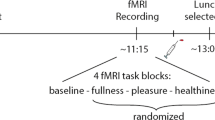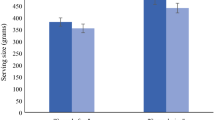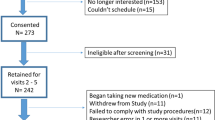Abstract
Background:
Obesity is related to a tendency to discount the future. Information regarding inter-meal interval (IMI) allows meal planning. We sought to assess how obese, overweight and lean people select portion sizes based on the length of an IMI. We hypothesised that individuals with a high body mass index (BMI) would discount information about the IMI. In addition, we investigated how reduced sensitivity to IMIs relates to monetary temporal discounting.
Methods:
Participants (lean, n=35; overweight, n=31; obese, n=22) selected lunchtime portion sizes in response to information about the timings of their next meal. In seven trials, the time of the IMI was systematically manipulated, ranging from ‘right now’ to ‘8 h’. Participants then completed a monetary temporal discounting task. BMI was included as a continuous measure. For each participant, we conducted a linear regression of portion size on IMI to yield a gradient that reflected reduced sensitivity to future meal timings.
Results:
As expected, participants selected larger portion sizes in response to a long IMI. Consistent with our hypothesis, individuals with a high BMI discounted information about the IMI (β=−3.49, P=0.015; confidence interval (CI) 6.29 to −0.70). Monetary discounting also negatively predicted BMI (β=−8.1, P=0.003; CI=−13.43 to −2.77), but did not correlate with IMI sensitivity (P>0.05).
Conclusions:
These results are the first to demonstrate that temporal discounting operates in planning from one meal to the next, and is more prevalent in obese and overweight, relative to lean individuals. Participants with a high BMI discounted concerns about potential future fullness and hunger in the IMI. Our observations might begin to explain associations between obesity and irregular meal timings or help to form the basis for a targeted intervention that promotes future thinking in meal planning.
This is a preview of subscription content, access via your institution
Access options
Subscribe to this journal
Receive 12 print issues and online access
$259.00 per year
only $21.58 per issue
Buy this article
- Purchase on Springer Link
- Instant access to full article PDF
Prices may be subject to local taxes which are calculated during checkout

Similar content being viewed by others
References
Moeller FG, Barratt ES, Dougherty DM, Schmitz JM, Swann AC . Psychiatric aspects of impulsivity. Am J Psychiatry 2001; 158: 1783–1793.
Rollins BY, Dearing KK, Epstein LH . Delay discounting moderates the effect of food reinforcement on energy intake among non-obese women. Appetite 2010; 55: 420–425.
Kulendran M, Vlaev I, Sugden C, King D, Ashrafian H, Gately P et al. Neuropsychological assessment as a predictor of weight loss in obese adolescents. Int J Obes (Lond) 2014; 38: 507–512.
Schiff S, Amodio P, Testa G, Nardi M, Montagnese S, Caregaro L et al. Impulsivity toward food reward is related to BMI: Evidence from intertemporal choice in obese and normal-weight individuals. Brain Cogn 2016; 110: 112–119.
Weller RE, Cook EW, Avsar KB, Cox JE . Obese women show greater delay discounting than healthy-weight women. Appetite 2008; 51: 563–569.
Manwaring JL, Green L, Myerson J, Strube MJ, Wilfley DE . Discounting of various types of rewards by women with and without binge eating disorder: evidence for general rather than specific differences. Psychol Rec 2011; 61: 561–582.
Mole TB, Irvine MA, Worbe Y, Collins P, Mitchell SP, Bolton S et al. Impulsivity in disorders of food and drug misuse. Psychol Med 2015; 45: 771–782.
Rasmussen EB, Lawyer SR, Reilly W . Percent body fat is related to delay and probability discounting for food in humans. Behav Processes 2010; 83: 23–30.
Stojek MM, Fischer S, Murphy CM, MacKillop J . The role of impulsivity traits and delayed reward discounting in dysregulated eating and drinking among heavy drinkers. Appetite 2014; 80: 81–88.
Stoeckel L, Murdaugh DL, Cox JE, Cook EW, Weller RE . Greater impulsivity is associated with decreased brain activation in obese women during a delay discounting task. Brain Imaging Behav 2013; 7: 116–128.
Hendrickson KL, Rasmussen EB, Lawyer SR . Measurement and validation of measures for impulsive food choice across obese and healthy-weight individuals. Appetite 2015; 90: 254–263.
Eisenstein SA, Gredysa DM, Antenor-Dorsey JA, Green L, Arbelaez AM, Koller JM et al. Insulin, central dopamine D2 receptors, and monetary reward discounting in obesity. PLoS ONE 2015; 10: e0133621.
Appelhans BM, Waring ME, Schneider KL, Pagoto SL, DeBiasse MA, Whited MC et al. Delay discounting and intake of ready-to-eat and away-from-home foods in overweight and obese women. Appetite 2012; 59: 576–584.
Critchfield TS, Kollins SH . Temporal discounting: basic research and the analysis of socially important behavior. J Appl Behav Anal 2001; 34: 101–122.
Barlow P, Reeves A, McKee M, Galea G, Stuckler D . Unhealthy diets, obesity and time discounting: a systematic literature review and network analysis. Obes Rev 2016; 17: 810–819.
Odum AL, Baumann AAL, Rimington DD . Discounting of delayed hypothetical money and food: Effects of amount. Behav Processes 2006; 73: 278–284.
Odum AL, Rainaud CP . Discounting of delayed hypothetical money, alcohol, and food. Behav Processes 2003; 64: 305–313.
Charlton SR, Fantino E . Commodity specific rates of temporal discounting: does metabolic function underlie differences in rates of discounting? Behav Processes 2008; 77: 334–342.
Amlung M, Petker T, Jackson J, Balodis I, MacKillop J . Steep discounting of delayed monetary and food rewards in obesity: a meta-analysis. Psychol Med 2016; 46: 2423–2434.
Houben K, Nederkoorn C, Jansen A . Eating on impulse: the relation between overweight and food-specific inhibitory control. Obesity (Silver Spring) 2014; 22: E6–E8.
Dassen FC, Houben K, Jansen A . Time orientation and eating behavior: unhealthy eaters consider immediate consequences, while healthy eaters focus on future health. Appetite 2015; 91: 13–19.
Zimmerman A, Ferriday D, Davies S, Martin A, Rogers P, Mason A et al. “What time is my next meal?” delay-discounting individuals choose smaller portions under conditions of uncertainty. Appetite 2017; 116: 284–290.
Kruger J, Blanck H, Gillespie C . Dietary and physical activity behaviors among adults successful at weight loss maintenance. Int J Behav Nutr Phys Act 2006; 3: 17.
Fay SH, Ferriday D, Hinton EC, Shakeshaft NG, Rogers PJ, Brunstrom JM . What determines real-world meal size? Evidence for pre-meal planning. Appetite 2011; 56: 284–289.
Wansink B, Cheney MM . Super bowls: Serving bowl size and food consumption. JAMA 2005; 293: 1723–1728.
Wilkinson LL, Hinton EC, Fay SH, Ferriday D, Rogers PJ, Brunstrom JM . Computer-based assessments of expected satiety predict behavioural measures of portion-size selection and food intake. Appetite 2012; 59: 933–938.
Brunstrom JM, Shakeshaft NG, Scott-Samuel NE . Measuring ‘expected satiety’ in a range of common foods using a method of constant stimuli. Appetite 2008; 51: 604–614.
Brunstrom JM, Rogers PJ . How many calories are on our plate? Expected fullness, not liking, determines meal-size selection. Obesity (Silver Spring) 2009; 17: 1884–1890.
da Matta A, Gonçalves FL, Bizarro L . Delay discounting: concepts and measures. Psychol Neurosci 2012; 5: 135–146.
Verplanken B, Sato A . The psychology of impulse buying: an integrative self-regulation approach. J Consumer Policy 2011; 34: 197–20.
Brunstrom JM, Collingwood J, Rogers PJ . Perceived volume, expected satiation, and the energy content of self-selected meals. Appetite 2010; 55: 25–29.
Du W, Green L, Myerson J . Cross-cultural comparisons of discounting delayed and probabilistic rewards. Psychol Rec 2002; 52: 479–492.
Myerson J, Green L, Warusawitharana M . Area under the curve as a measure of discounting. J Exp Anal Behav 2001; 76: 235–243.
Stunkard AJ, Messick S . The three-factor eating questionnaire to measure dietary restraint, disinhibition and hunger. J Psychosom Res 1985; 29: 71–83.
Brunstrom JM, Jarvstad A, Griggs RL, Potter C, Evans NR, Martin AA et al. Large portions encourage the selection of palatable rather than filling foods. J Nutr 2016; 146: 2117–2123.
Hendrickson KL, Rasmussen EB . Effects of mindful eating training on delay and probability discounting for food and money in obese and healthy-weight individuals. Behav Res Ther 2013; 51: 399–409.
Daniel TO, Stanton CM, Epstein LH . The future is now: comparing the effect of episodic future thinking on impulsivity in lean and obese individuals. Appetite 2013; 71: 120–125.
Herbert BM, Blechert J, Hautzinger M, Matthias E, Herbert C . Intuitive eating is associated with interoceptive sensitivity. Effects on body mass index. Appetite 2013; 70: 22–30.
Stunkard. A . Obesity and the denial of hunger. Psychosom Med 1959; 21: 281–290.
Herbert BM, Pollatos O . Attenuated interoceptive sensitivity in overweight and obese individuals. Eat Behav 2014; 15: 445–448.
Geliebter A, Westreich S, Gage D . Gastric distention by balloon and test-meal intake in obese and lean subjects. Am J Clin Nutr 1988; 48: 592–594.
Farshchi H, Taylor M, Macdonald I . Deleterious effects of omitting breakfast on insulin sensitivity and fasting lipid profiles in healthy lean women. Am J Clin Nutr 2005; 81: 388–396.
Aggarwal B, Liao M, Allegrante JP, Mosca L . Low social support level is associated with non-adherence to diet at 1-year in the family intervention trial for heart health (FIT Heart). J Nutr Educ Behav 2010; 42: 380–388.
Thuan JF, Avignon A . Obesity management: attitudes and practices of French general practitioners in a region of France. Int J Obes 2005; 29: 1100–1106.
Pijls LT, de Vries H, van Eijk JT, Donker AJ . Adherence to protein restriction in patients with type 2 diabetes mellitus: a randomized trial. Eur J Clin Nutr 2000; 54: 347–352.
Weygandt M, Mai K, Dommes E, Ritter K, Leupelt V, Spranger J et al. Impulse control in the dorsolateral prefrontal cortex counteracts post-diet weight regain in obesity. Neuroimage 2015; 109: 318–327.
Dassen FC, Jansen A, Nederkoorn C, Houben K . Focus on the future: episodic future thinking reduces discount rate and snacking. Appetite 2016; 96: 327–332.
Green L, Myerson J . How many impulsivities? A discounting perspective. J Exp Anal Behav 2013; 99: 3–13.
Taylor JC, Yon BA, Johnson RK . Reliability and validity of digital imaging as a measure of schoolchildren's fruit and vegetable consumption. J Acad Nutr Diet 2014; 114: 1359–1366.
Pouyet V, Cuvelier G, Benattar L, Giboreau A . A photographic method to measure food item intake. Validation in geriatric institutions. Appetite 2015; 84: 11–19.
Johansson G, Wikman A, Ahrén A-M, Johansson I . Underreporting of energy intake in repeated 24-hour recalls related to gender, age, weight status, day of interview, educational level, reported food intake, smoking habits and area of living. Public Health Nutr 2001; 4: 919–927.
Okubo H, Sasaki S . Underreporting of energy intake among Japanese women aged 18-20 years and its association with reported nutrient and food group intakes. Public Health Nutr 2004; 7: 911–917.
Acknowledgements
Work conducted at the University of Bristol was supported by the Biotechnology and Biological Sciences Research Council (BBSRC, grant references BB/ I012370/1 and BB/J00562/1). The research of Brunstrom, Rogers and Zimmerman is currently supported by the European Union Seventh Framework Programme (FP7/2007-2013, under Grant Agreement 607310 (Nudge-it)).
Author information
Authors and Affiliations
Corresponding author
Ethics declarations
Competing interests
The authors declare no conflict of interest.
Rights and permissions
About this article
Cite this article
Zimmerman, A., Mason, A., Rogers, P. et al. Obese and overweight individuals are less sensitive to information about meal times in portion-size judgements. Int J Obes 42, 905–910 (2018). https://doi.org/10.1038/ijo.2017.275
Received:
Revised:
Accepted:
Published:
Issue Date:
DOI: https://doi.org/10.1038/ijo.2017.275



